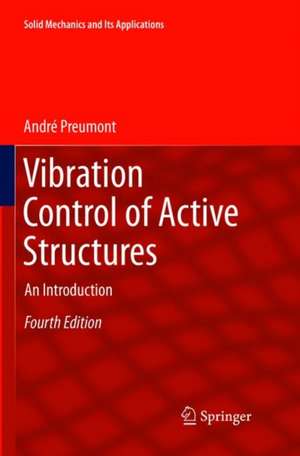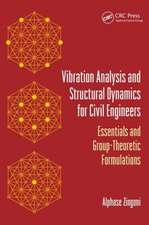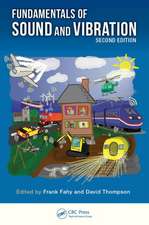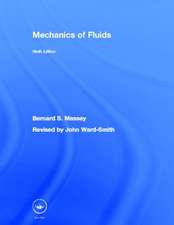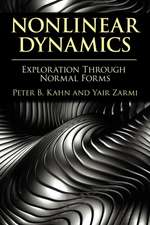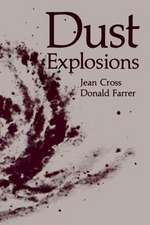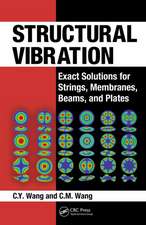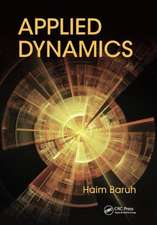Vibration Control of Active Structures: An Introduction: Solid Mechanics and Its Applications, cartea 246
Autor André Preumonten Limba Engleză Paperback – 4 iun 2019
Now in its fourth edition, more chapters have been added, and comments and feedback from readers have been taken into account, while at the same time the unique premise of bridging the gap between structure and control has remained. Many examples, covering a broad field of applications from bridges to satellites and telescopes, and problems bring the subject to life and take the audience from theory to practice.
The book has 19 chapters dealing with some concepts in structural dynamics; electromagnetic and piezoelectric transducers; piezoelectric beam, plate and truss; passive damping with piezoelectric transducers; collocated versus non-collocated control; active damping with collocated systems; vibration isolation; state space approach; analysis and synthesis in the frequency domain; optimal control; controllability and observability; stability; applications; tendon control of cable structures; active control of deformable mirrors for Adaptive Optics and large earth-based and space telescopes; and semi-active control. The book concludes with an exhaustive bibliography and index.
This book is intended for structural engineers who want to acquire some background in vibration control, and for control engineers who are dealing with flexible structures. It can be used as a textbook for a graduate course on vibration control or active structures.
A solutions manual is available through the publisher to teachers using this book as a textbook.
| Toate formatele și edițiile | Preț | Express |
|---|---|---|
| Paperback (1) | 481.35 lei 38-45 zile | |
| Springer International Publishing – 4 iun 2019 | 481.35 lei 38-45 zile | |
| Hardback (1) | 535.75 lei 38-45 zile | |
| Springer International Publishing – 19 feb 2018 | 535.75 lei 38-45 zile |
Din seria Solid Mechanics and Its Applications
- 20%
 Preț: 698.10 lei
Preț: 698.10 lei - 24%
 Preț: 800.16 lei
Preț: 800.16 lei -
 Preț: 402.14 lei
Preț: 402.14 lei - 15%
 Preț: 640.06 lei
Preț: 640.06 lei - 15%
 Preț: 653.14 lei
Preț: 653.14 lei - 18%
 Preț: 1124.92 lei
Preț: 1124.92 lei - 15%
 Preț: 643.84 lei
Preț: 643.84 lei - 18%
 Preț: 1119.38 lei
Preț: 1119.38 lei - 20%
 Preț: 573.20 lei
Preț: 573.20 lei - 18%
 Preț: 1607.92 lei
Preț: 1607.92 lei - 17%
 Preț: 393.72 lei
Preț: 393.72 lei - 17%
 Preț: 459.41 lei
Preț: 459.41 lei - 18%
 Preț: 959.98 lei
Preț: 959.98 lei - 18%
 Preț: 747.71 lei
Preț: 747.71 lei -
 Preț: 388.55 lei
Preț: 388.55 lei - 18%
 Preț: 787.15 lei
Preț: 787.15 lei -
 Preț: 406.25 lei
Preț: 406.25 lei - 15%
 Preț: 639.08 lei
Preț: 639.08 lei - 24%
 Preț: 784.84 lei
Preț: 784.84 lei - 15%
 Preț: 643.34 lei
Preț: 643.34 lei - 18%
 Preț: 958.07 lei
Preț: 958.07 lei - 18%
 Preț: 1228.15 lei
Preț: 1228.15 lei - 18%
 Preț: 734.27 lei
Preț: 734.27 lei - 18%
 Preț: 1233.06 lei
Preț: 1233.06 lei - 18%
 Preț: 1236.19 lei
Preț: 1236.19 lei - 18%
 Preț: 950.96 lei
Preț: 950.96 lei - 18%
 Preț: 906.48 lei
Preț: 906.48 lei - 18%
 Preț: 964.54 lei
Preț: 964.54 lei - 20%
 Preț: 995.75 lei
Preț: 995.75 lei - 18%
 Preț: 953.65 lei
Preț: 953.65 lei - 18%
 Preț: 1239.67 lei
Preț: 1239.67 lei - 18%
 Preț: 962.35 lei
Preț: 962.35 lei - 18%
 Preț: 964.54 lei
Preț: 964.54 lei - 18%
 Preț: 913.11 lei
Preț: 913.11 lei - 18%
 Preț: 1226.90 lei
Preț: 1226.90 lei
Preț: 481.35 lei
Nou
Puncte Express: 722
Preț estimativ în valută:
92.10€ • 96.51$ • 76.14£
92.10€ • 96.51$ • 76.14£
Carte tipărită la comandă
Livrare economică 07-14 aprilie
Preluare comenzi: 021 569.72.76
Specificații
ISBN-13: 9783319891682
ISBN-10: 3319891685
Pagini: 518
Ilustrații: XXIV, 518 p. 339 illus.
Dimensiuni: 155 x 235 mm
Ediția:Softcover reprint of the original 4th ed. 2018
Editura: Springer International Publishing
Colecția Springer
Seria Solid Mechanics and Its Applications
Locul publicării:Cham, Switzerland
ISBN-10: 3319891685
Pagini: 518
Ilustrații: XXIV, 518 p. 339 illus.
Dimensiuni: 155 x 235 mm
Ediția:Softcover reprint of the original 4th ed. 2018
Editura: Springer International Publishing
Colecția Springer
Seria Solid Mechanics and Its Applications
Locul publicării:Cham, Switzerland
Cuprins
Preface to the third edition.- Preface to the second edition.- Preface to the first edition.- 1 Introduction.- 1.1 Active versus passive.- 1.2 Vibration suppression.- 1.3 Smart materials and structures.- 1.4 Control strategies.- 1.4.1 Feedback.- 1.4.2 Feedforward.- 1.5 The various steps of the design.- 1.6 Plant description, error and control budget.- 1.7 Readership and Organization of the book.- 1.8 References.- 1.9 Problems.- 2 Some concepts in structural dynamics.- 2.1 Introduction.- 2.2 Equation of motion of a discrete system.- 2.3 Vibration modes.- 2.4 Modal decomposition.- 2.4.1 Structure without rigid body modes.- 2.4.2 Dynamic °exibility matrix.- 2.4.3 Structure with rigid body modes.- 2.4.4 Example.- 2.5 Collocated control system.- 2.5.1 Transmission zeros and constrained system.- 2.6 Continuous structures.- 2.7 Guyan reduction.- 2.8 Craig-Bampton reduction.- 2.9 References.- 2.10 Problems.- 3 Electromagnetic and piezoelectric transducers.- 3.1 Introduction.- 3.2 Voice coil transducer.- 3.2.1 Proof-mass actuator.- 3.2.2 Geophone.- 3.3 General electromechanical transducer.- 3.3.1 Constitutive equations.- 3.3.2 Self-sensing.- 3.4 Reaction wheels and gyrostabilizers.- 3.5 Smart materials.- 3.6 Piezoelectric transducer.- 3.6.1 Constitutive relations of a discrete transducer.- 3.6.2 Interpretation of k2.- 3.6.3 Admittance of the piezoelectric transducer.- 3.7 References.- 3.8 Problems.- 4 Piezoelectric beam, plate and truss.- 4.1 Piezoelectric material.- 4.1.1 Constitutive relations.- 4.1.2 Coenergy density function.- 4.2 Hamilton's principle.- 4.3 Piezoelectric beam actuator.- 4.3.1 Hamilton's principle.- 4.3.2 Piezoelectric loads.- 4.4 Laminar sensor.- 4.4.1 Current and charge amplifiers.- 4.4.2 Distributed sensor output.- 4.4.3 Charge amplifier dynamics.- 4.5 Spatial modalfilters.- 4.5.1 Modal actuator.- 4.5.2 Modal sensor.- 4.6 Active beam with collocated actuator-sensor.- 4.6.1 Frequency response function.- 4.6.2 Pole-zero pattern.- 4.6.3 Modal truncation.- 4.7 Admittance of a beam with a piezoelectric patch.- 4.8 Piezoelectric laminate.- 4.8.1 Two dimensional constitutive equations.- 4.8.2 Kirchhoff theory.- 4.8.3 Stiffness matrix of a multi-layer elastic laminate.- 4.8.4 Multi-layer laminate with a piezoelectric layer.- 4.8.5 Equivalent piezoelectric loads.- 4.8.6 Sensor output.- 4.8.7 Beam model vs. plate model.- 4.8.8 Additional remarks.- 4.9 Active truss.- 4.9.1 Open-loop transfer function.- 4.9.2 Admittance function.- 4.10 Finite element formulation.- 4.11 References.- 4.12 Problems.- 5 Passive damping with piezoelectric transducers.- 5.1 Introduction.- 5.2 Resistive shunting.- 5.3 Inductive shunting.- 5.4 Switched shunt.- 5.4.1 Equivalent damping ratio.- 5.5 References.- 5.6 Problems.- 6 Collocated versus non-collocated control.- 6.1 Introduction.- 6.2 Pole-zero flipping.- 6.3 The two-mass problem.- 6.3.1 Collocated control.- 6.3.2 Non-collocated control.- 6.4 Notch filter.- 6.5 Effect of pole-zero flipping on the Bode plots.- 6.6 Nearly collocated control system.- 6.7 Non-collocated control systems.- 6.8 The role of damping.- 6.9 References.- 6.10 Problems ..- 7 Active damping with collocated system.- 7.1 Introduction.- 7.2 Lead control.- 7.3 Direct velocity feedback (DVF).- 7.4 Positive Position Feedback (PPF).- 7.5 Integral Force Feedback(IFF).- 7.6 Duality between the Lead and the IFF controllers.- 7.6.1 Root-locus of a single mode.- 7.6.2 Open-loop poles and zeros.- 7.7 Actuator and sensor dynamics.- 7.8 Decentralized control with collocated pairs.- 7.8.1 Cross talk.- 7.8.2 Force actuator and displacement sensor.- 7.8.3 Displacement actuator and force sensor.- 7.9 References.- 7.10 Problems.- 8 Vibration isolation.- 8.1 Introduction.- 8.2 Relaxation isolator.- 8.2.1 Electromagnetic realization.- 8.3 Active isolation.- 8.3.1 Sky-hook damper.- 8.3.2 Integral Force Feedback.- 8.4 Flexible body.- 8.4.1 Free-free beam with isolator.- 8.5 Payload isolation in spacecraft.- 8.5.1 Interaction isolator/attitude control.- 8.5.2 Gough-Stewart platform.- 8.6 Six-axis isolator.- 8.6.1 Relaxation isolator.- 8.6.2 Integral Force Feedback.- 8.6.3 Spherical joints, modal spread.- 8.7 Active vs. passive.- 8.8 Car suspension.- 8.9 References.- 8.10 Problems.- 9 State space approach.- 9.1 Introduction.- 9.2 State space description.- 9.2.1 Single degree of freedom oscillator.- 9.2.2 Flexible structure.- 9.2.3 Inverted pendulum.- 9.3 System transfer function.- 9.3.1 Poles and zeros.- 9.4 Pole placement by state feedback.- 9.4.1 Example: oscillator.- 9.5 Linear Quadratic Regulator.- 9.5.1 Symmetric root locus.- 9.5.2 Inverted pendulum.- 9.6 Observer design.- 9.7 Kalman Filter.- 9.7.1 Inverted pendulum.- 9.8 Reduced order observer.- 9.8.1 Oscillator.- 9.8.2 Inverted pendulum.- 9.9 Separation principle.- 9.10 Transfer function of the compensator.- 9.10.1 The two-mass problem.- 9.11 References.- 9.12 Problems.- 10 Analysis and synthesis in the frequency domain.- 10.1 Gain and phase margins.- 10.2 Nyquist criterion.- 10.2.1 Cauchy's principle.- 10.2.2 Nyquist stability criterion.- 10.3 Nichols chart.- 10.4 Feedback specification for SISO systems.- 10.4.1 Sensitivity.- 10.4.2 Tracking error.- 10.4.3 Performance specification.- 10.4.4 Unstructured uncertainty.- 10.4.5 Robust performance and robust stability.- 10.5 Bode gain-phase relationships.- 10.6 The Bode Ideal Cutoff.- 10.7 Non-minimum phase systems.- 10.8 Usual compensators.- 10.8.1 System type.- 10.8.2 Lead compensator.- 10.8.3 PI compensator.- 10.8.4 Lag compensator.- 10.8.5 PID compensator.- 10.9 Multivariable systems.- 10.9.1 Performance specification.- 10.9.2 Small gaintheorem.- 10.9.3 Stability robustness tests.- 10.9.4 Residual dynamics.- 10.10References.- 10.11Problems.- 11 Optimal control.- 11.1 Introduction.- 11.2 Quadratic integral.- 11.3 Deterministic LQR.- 11.4 Stochastic response to a white noise.- 11.4.1 Remark.- 11.5 Stochastic LQR.- 11.6 Asymptotic behavior of the closed-loop.- 11.7 Prescribed degree of stability.- 11.8 Gain and phase margins of the LQR.- 11.9 Full state observer.- 11.9.1 Covariance of the reconstruction error.- 11.10Kalman-Bucy Filter (KBF).- 11.11Linear Quadratic Gaussian (LQG).- 11.12Duality.- 11.13Spillover.- 11.13.1Spillover reduction.- 11.14Loop Transfer Recovery (LTR).- 11.15Integral control with state feedback.- 11.16Frequency shaping.- 11.16.1Frequency-shaped cost functionals.- 11.16.2Noise model ..- 11.17References.- 11.18Problems.- 12 Controllability and Observability.- 12.1 Introduction.- 12.1.1 Definitions.- 12.2 Controllability and observabilitymatrices.- 12.3 Examples.- 12.3.1 Cart with two inverted pendulums.- 12.3.2 Double inverted pendulum.- 12.3.3 Two d.o.f. oscillator.- 12.4 State transformation.- 12.4.1 Control canonical form.- 12.4.2 Left and right eigenvectors.- 12.4.3 Diagonal form.- 12.5 PBH test.- 12.6 Residues.- 12.7 Example.- 12.8 Sensitivity.- 12.9 Controllability and observability Gramians.- 12.10Internally balanced coordinates.- 12.11Model reduction.- 12.11.1Transfer equivalent realization.- 12.11.2Internally balanced realization.- 12.11.3Example.- 12.12References.- 12.13Problems.- 13 Stability.- 13.1 Introduction.- 13.1.1 Phase portrait.- 13.2 Linear systems.- 13.2.1 Routh-Hurwitz criterion.- 13.3 Lyapunov's direct method.- 13.3.1 Introductory example.- 13.3.2 Stability theorem.- 13.3.3 Asymptotic stability theorem.- 13.3.4 Lasalle's theorem.- 13.3.5 Geometric interpretation.- 13.3.6 Instability theorem.- 13.4 Lyapunov functions for linear systems.- 13.5 Lyapunov's indirect method ..- 13.6 An application to controller design.- 13.7 Energy absorbing controls.- 13.8 References.- 13.9 Problems.- 14 Applications.- 14.1 Digital implementation.- 14.1.1 Sampling, aliasing and prefiltering.- 14.1.2 Zero-order hold, computational delay.- 14.1.3 Quantization.- 14.1.4 Discretization of a continuous controller.- 14.2 Active damping of a truss structure.- 14.2.1 Actuator placement.- 14.2.2 Implementation, experimental results.- 14.3 Active damping generic interface.- 14.3.1 Active damping.- 14.3.2 Experiment.- 14.3.3 Pointing and position control.- 14.4 Active damping of a plate.- 14.4.1 Control design.- 14.5 Active damping of a stiff beam.- 14.5.1 System design.- 14.6 The HAC/LAC strategy.- 14.6.1 Wide-band position control.- 14.6.2 Compensator design.- 14.6.3 Results.- 14.7 Vibroacoustics: Volume displacement sensors.- 14.7.1 QWSIS sensor.- 14.7.2 Discrete array sensor.- 14.7.3 Spatial aliasing.- 14.7.4 Distributed sensor.- 14.8 References.- 14.9 Problems.- 5 Tendon Control of Cable Structures.- 15.1 Introduction.- 15.2 Tendon control of strings and cables.- 15.3 Active damping strategy.- 15.4 Basic Experiment.- 15.5 Linear theory of decentralized active damping.- 15.6 Guyed truss experiment.- 15.7 Micro Precision Interferometer testbed.- 15.8 Free floating truss experiment.- 15.9 Application to cable-stayed bridges.- 15.10Laboratory experiment.- 15.11Control of parametric resonance.- 15.12Large scale experiment.- 15.13 References.- 16 Active Control of Large Telescopes.- 16.1 Introduction.- 16.2 Adaptive optics.- 16.3 Active optics.- 16.3.1 Monolithic primary mirror.- 16.3.2 Segmented primary mirror.- 16.4 SVD controller.- 16.4.1 Loop shaping of the SVD controller.- 16.5 Dynamics of a segmented mirror.- 16.6 Control-structure interaction.- 16.6.1 Multiplicative uncertainty.- 16.6.2 Additive uncertainty.- 16.6.3 Discussion.- 16.7 References.- 17 Semi-active control.- 17.1 Introduction.- 17.2 Magneto-rheological fluids.- 17.3 MR devices.- 17.4 Semi-active suspension.- 17.4.1 Semi-active devices.- 17.5 Narrow-band disturbance.- 17.5.1 Quarter-car semi-active suspension.- 17.6 References.- 17.7 Problems.- Bibliography.- Index.
Recenzii
“The fourth edition of the textbook should serve as an outstanding updated and extended reference book for structural engineers, control engineers, students, and for applied mathematicians interested in this emerging area.” (Lubomír Bakule, zbMATH 1443.74002, 2020)
Notă biografică
André Preumont received his MSc in Aeronautics from the University of Liege in 1973 and his PhD in Applied Sciences in 1981. He spent 10 years in industry before moving in academia. He has been a professor of Mechanical Engineering and Robotics at the Université Libre de Bruxelles (ULB) since 1987, full professor since 1991, and director of the Active Structures Laboratory. He is the author of 7 books. He is a member of the Belgian Royal Academy and was the recipient of the Alexander von Humboldt Research Award in 2011 (Darmstadt, Germany). He was a visiting professor at Virginia Tech (USA), UT Compiègne and INSA Lyon (France), and Politecnico di Milano (Italy). He is a Fellow of the American Institute of Aeronautics and Astronautics. His current researches include Adaptive Optics, Active damping of structures and flapping wing robots.
Textul de pe ultima copertă
This textbook is an introduction to the dynamics of active structures and to the feedback control of lightly damped flexible structures; the emphasis is placed on basic issues and simple control strategies that work.
Now in its fourth edition, more chapters have been added, and comments and feedback from readers have been taken into account, while at the same time the unique premise of bridging the gap between structure and control has remained. Many examples, covering a broad field of applications from bridges to satellites and telescopes, and problems bring the subject to life and take the audience from theory to practice.
The book has 19 chapters dealing with some concepts in structural dynamics; electromagnetic and piezoelectric transducers; piezoelectric beam, plate and truss; passive damping with piezoelectric transducers; collocated versus non-collocated control; active damping with collocated systems; vibration isolation; state space approach; analysis and synthesis in the frequency domain; optimal control; controllability and observability; stability; applications; tendon control of cable structures; active control of deformable mirrors for Adaptive Optics and large earth-based and space telescopes; and semi-active control. The book concludes with an exhaustive bibliography and index.
This book is intended for structural engineers who want to acquire some background in vibration control, and for control engineers who are dealing with flexible structures. It can be used as a textbook for a graduate course on vibration control or active structures.
A solutions manual is available through the publisher to teachers using this book as a textbook.
Now in its fourth edition, more chapters have been added, and comments and feedback from readers have been taken into account, while at the same time the unique premise of bridging the gap between structure and control has remained. Many examples, covering a broad field of applications from bridges to satellites and telescopes, and problems bring the subject to life and take the audience from theory to practice.
The book has 19 chapters dealing with some concepts in structural dynamics; electromagnetic and piezoelectric transducers; piezoelectric beam, plate and truss; passive damping with piezoelectric transducers; collocated versus non-collocated control; active damping with collocated systems; vibration isolation; state space approach; analysis and synthesis in the frequency domain; optimal control; controllability and observability; stability; applications; tendon control of cable structures; active control of deformable mirrors for Adaptive Optics and large earth-based and space telescopes; and semi-active control. The book concludes with an exhaustive bibliography and index.
This book is intended for structural engineers who want to acquire some background in vibration control, and for control engineers who are dealing with flexible structures. It can be used as a textbook for a graduate course on vibration control or active structures.
A solutions manual is available through the publisher to teachers using this book as a textbook.
Caracteristici
Fourth updated and expanded edition of this textbook Third edition won a TAA Textbook Award! Bridges the gap between structure and control Proven to be successful as a course text Solution manual available upon request
